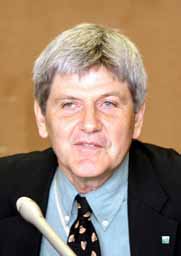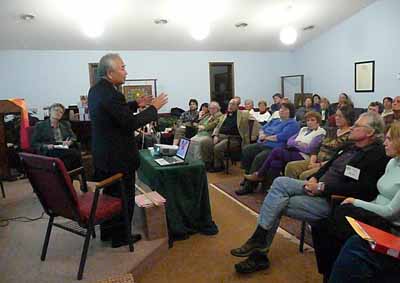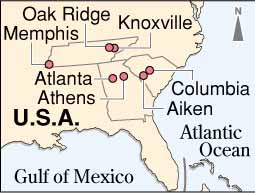A-bomb testimony fosters reconciliation
Feb. 1, 2008
by Steven Leeper, Chairman of the Hiroshima Peace Culture Foundation
Steven Leeper has been traveling through the United States in support of the city of Hiroshima’s effort to hold Atomic Bomb Exhibitions in 101 American cities--two in each state plus the District of Columbia--in the run-up to the U.S. presidential election. The aim of this project is to raise awareness of the issue of nuclear weapons and disarmament during this pivotal presidential race. These exhibitions include presentations by hibakusha (A-bomb survivors) sharing their personal accounts of the bombing.
Takashi Teramoto, (73, an A-bomb survivor) and Natsuki Okita (an interpreter) arrived in Atlanta on January 11. Since then we have made presentations in Atlanta, Georgia (3 times), Athens, Georgia (2), Aiken, South Carolina (2), Columbia, South Carolina (2), Memphis, Tennessee (2), Knoxville, Tennessee (1), and Oak Ridge, Tennessee (1, the city where the uranium used in the atomic bomb dropped on Hiroshima was refined).
We have spoken to junior high students, high school students, college students, adults and seniors. Most of these people have attended voluntarily, but many of the students had little choice. Nevertheless, we have encountered almost no resistance. People listen carefully, then ask friendly and curious questions. They are really seeking more information.
In almost every venue, when the presentations are finished, many people come up to us and say, “Thank you so much for coming here to talk to us. I had no idea about that bombing. We just have never heard a story like this. You have given us so much new information.” We do get questions about whether or not the bombings saved a million lives, but when we explain that the bombings were not necessary given the actual historical conditions of the time, our explanation is accepted without resistance.
In Atlanta, we held an event at a teahouse, a highly unusual venue. It was a funky place chosen by a brilliant activist named Karris. Thanks to meeting in that venue, our audience of about 80 people included about 60 people in their late 20s and early 30s. After the presentation, many approached us to express their amazement and gratitude for the information we presented.
In Columbia, a woman approached and said, “My grandmother is Japanese. She left Hiroshima after the bombing and moved to Aomori Prefecture (in northern Japan). She never told us about the bombing, and now, thanks to you, I feel I have some understanding of what she must have gone through.”
In Athens, we spoke to a large audience of over 300 people. There the event and the exhibition was sponsored by a graphic artist named Neal Summourer, who went to Hiroshima when he was sixteen, then took a group of students there about ten years later. He feels a special connection to Hiroshima, so when he heard we were trying to do an exhibition there, he immediately donated $1000.
In Aiken, we met people who are directly affected by radiation. Aiken is close to the Savannah River Site, a nuclear weapons facility and one of the most radioactive places on Earth. They were eager to find out as much as possible about the effects of low-level radiation exposure. We were not too helpful in that regard, but the people we met there are politically sophisticated and promised to take up our campaign. I am sure they will be a big help.
All of this is because Mr. Teramoto is a real professional. At first, he had a little problem knowing how to adapt to the strange venues, the makeshift equipment and interpretation. But he soon learned, and now, no matter how much or how little time he is given, he ends exactly on time and manages to touch hearts and minds. I have now heard him tell his story about 15 times, but he still surprises me now and then with new details. He really seems to respond to each individual audience.
One of the best results of this tour has been the amount of coverage we have been receiving by the media. Although some of our audiences have been only about 30 people, we have been covered extensively by both campus and local newspapers. Some reporters have simply taken their information from the local organizers, but a Chinese-American reporter from Athens came all the way to Atlanta to do an extensive interview that resulted in an extremely friendly and helpful article in the campus newspaper. Another reporter from Athens interviewed us by phone for the city newspaper.
We have had television stations filming our presentations in Aiken, Athens, Columbia and Memphis, and I am writing now in Memphis the night before we appear on a one-hour live television program tomorrow morning. We could never afford to purchase this much publicity, and I have been surprised by the extent to which individual reporters have worked so hard to help us get our message out.
Above all, I have been overwhelmed by the hard work and generosity of the people who have been organizing our tour. They have worked hard and spent a lot of their own time, energy and money to set up our exhibitions. They have publicized our speaking events. They have taken us out to eat, invited us to their houses, and have always made us feel welcomed and even honored. Over and over I am reminded of the warmth and openness characteristic of many Americans. So many of them approach Mr. Teramoto, take his hands in theirs, look deep into his eyes and say, full of emotion, “Thank you so much for coming. It is a great honor to have you here.” I enjoy watching these moments of reconciliation, and I am furious that so many world leaders still try so hard to make these loving people hate each other.
Steven Leeper has been traveling through the United States in support of the city of Hiroshima’s effort to hold Atomic Bomb Exhibitions in 101 American cities--two in each state plus the District of Columbia--in the run-up to the U.S. presidential election. The aim of this project is to raise awareness of the issue of nuclear weapons and disarmament during this pivotal presidential race. These exhibitions include presentations by hibakusha (A-bomb survivors) sharing their personal accounts of the bombing.
Takashi Teramoto, (73, an A-bomb survivor) and Natsuki Okita (an interpreter) arrived in Atlanta on January 11. Since then we have made presentations in Atlanta, Georgia (3 times), Athens, Georgia (2), Aiken, South Carolina (2), Columbia, South Carolina (2), Memphis, Tennessee (2), Knoxville, Tennessee (1), and Oak Ridge, Tennessee (1, the city where the uranium used in the atomic bomb dropped on Hiroshima was refined).
We have spoken to junior high students, high school students, college students, adults and seniors. Most of these people have attended voluntarily, but many of the students had little choice. Nevertheless, we have encountered almost no resistance. People listen carefully, then ask friendly and curious questions. They are really seeking more information.
In almost every venue, when the presentations are finished, many people come up to us and say, “Thank you so much for coming here to talk to us. I had no idea about that bombing. We just have never heard a story like this. You have given us so much new information.” We do get questions about whether or not the bombings saved a million lives, but when we explain that the bombings were not necessary given the actual historical conditions of the time, our explanation is accepted without resistance.
In Atlanta, we held an event at a teahouse, a highly unusual venue. It was a funky place chosen by a brilliant activist named Karris. Thanks to meeting in that venue, our audience of about 80 people included about 60 people in their late 20s and early 30s. After the presentation, many approached us to express their amazement and gratitude for the information we presented.
In Columbia, a woman approached and said, “My grandmother is Japanese. She left Hiroshima after the bombing and moved to Aomori Prefecture (in northern Japan). She never told us about the bombing, and now, thanks to you, I feel I have some understanding of what she must have gone through.”
In Athens, we spoke to a large audience of over 300 people. There the event and the exhibition was sponsored by a graphic artist named Neal Summourer, who went to Hiroshima when he was sixteen, then took a group of students there about ten years later. He feels a special connection to Hiroshima, so when he heard we were trying to do an exhibition there, he immediately donated $1000.
In Aiken, we met people who are directly affected by radiation. Aiken is close to the Savannah River Site, a nuclear weapons facility and one of the most radioactive places on Earth. They were eager to find out as much as possible about the effects of low-level radiation exposure. We were not too helpful in that regard, but the people we met there are politically sophisticated and promised to take up our campaign. I am sure they will be a big help.
All of this is because Mr. Teramoto is a real professional. At first, he had a little problem knowing how to adapt to the strange venues, the makeshift equipment and interpretation. But he soon learned, and now, no matter how much or how little time he is given, he ends exactly on time and manages to touch hearts and minds. I have now heard him tell his story about 15 times, but he still surprises me now and then with new details. He really seems to respond to each individual audience.
One of the best results of this tour has been the amount of coverage we have been receiving by the media. Although some of our audiences have been only about 30 people, we have been covered extensively by both campus and local newspapers. Some reporters have simply taken their information from the local organizers, but a Chinese-American reporter from Athens came all the way to Atlanta to do an extensive interview that resulted in an extremely friendly and helpful article in the campus newspaper. Another reporter from Athens interviewed us by phone for the city newspaper.
We have had television stations filming our presentations in Aiken, Athens, Columbia and Memphis, and I am writing now in Memphis the night before we appear on a one-hour live television program tomorrow morning. We could never afford to purchase this much publicity, and I have been surprised by the extent to which individual reporters have worked so hard to help us get our message out.
Above all, I have been overwhelmed by the hard work and generosity of the people who have been organizing our tour. They have worked hard and spent a lot of their own time, energy and money to set up our exhibitions. They have publicized our speaking events. They have taken us out to eat, invited us to their houses, and have always made us feel welcomed and even honored. Over and over I am reminded of the warmth and openness characteristic of many Americans. So many of them approach Mr. Teramoto, take his hands in theirs, look deep into his eyes and say, full of emotion, “Thank you so much for coming. It is a great honor to have you here.” I enjoy watching these moments of reconciliation, and I am furious that so many world leaders still try so hard to make these loving people hate each other.









